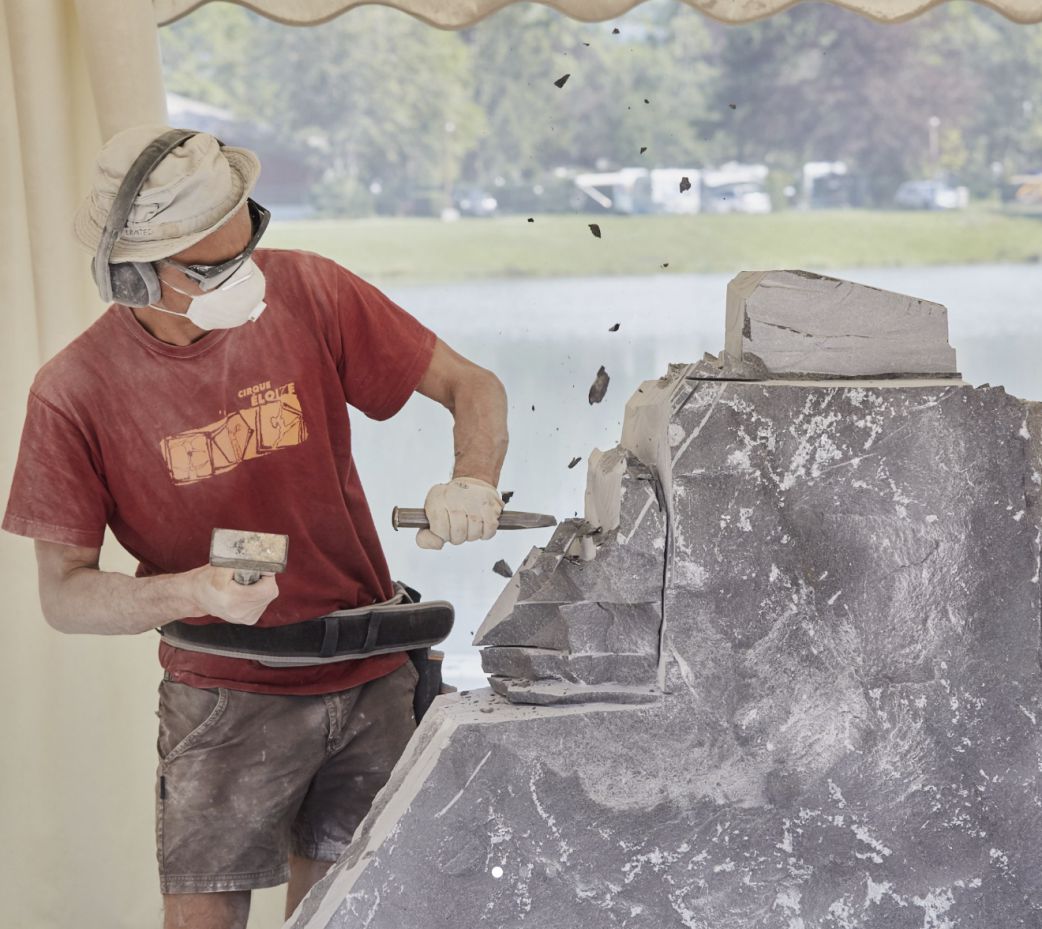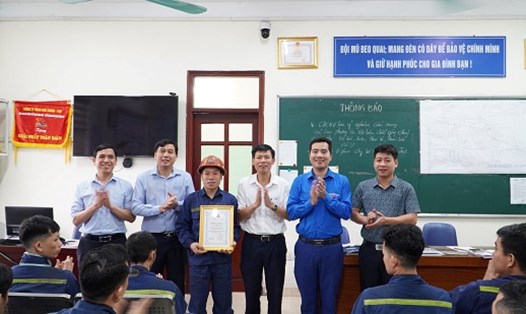Memories of the past
“Look, that’s my father,” said Pierre Bianco, 81, pointing to a black-and-white frame in the album. In the old, slightly blurry photo, a man in a soft hat and vest stands with a group of about a dozen people at the entrance to a quarry. They appear to be colleagues, all looking straight into the camera lens, their postures serious. One is riding a horse, driving a cart with a cargo box on the back. “This photo was taken in 1903… The horses would climb the quarry and carry the stone back to town,” Pierre said.
The small town of Samoens is located in the Giffre Valley in the Haute-Savoie region of the French Alps. According to local legend, the town’s name originally meant “seven mountains,” referring to the towering limestone peaks that surround it. The thick, calloused hands of Pierre Bianco, a stonemason like his father, testify to a lifetime spent working with limestone, first building houses, then creating intricate, seemingly gravity-defying works of art. Among the hand-carved sculptures that line Pierre’s living room are marble-smooth spheres that rotate slowly on fragile glass stands.
Flipping through the album, Pierre picked up another photo, a group of young men looking pensive. They were holding pickaxes and wooden sticks, which Pierre explained were tools used to push explosives into crevices in rocks. The images in the album were part of a larger collection of newspaper clippings, sketches and illustrations that formed a record of a profession, a traditional art form that was in danger of disappearing. “There are very few young people who want to do stone carving these days,” Pierre Bianco said with a sigh. “It’s sad, but it’s very difficult to make a living in this profession.”
Pierre is one of only two stonemasons left in Samoens, a profession that was once passed down from father to son and brought fame and wealth to the valley. In the 17th century, Samoens was highly regarded for its stonemasons, known locally as “frahan.” Their reputation was widespread: they traveled throughout France, working on projects for the famous military engineer Vauban and building canals at Saint Quentin and the Rhone-Rhine. The French philosopher, novelist and playwright Voltaire was so impressed by their talents that he hired them to build his castle at Ferney-Voltaire.
“The furthest we know they went was Louisiana,” said Aurelie Veisy, a heritage guide in Savoie Mont Blanc, France. “The names of the three stonemasons are recorded in the archives of the city of New Orleans.”
Like many success stories, the story of the frahans is a combination of necessity, opportunity and luck. Mountain farmers often sought extra work during the winter months, when their fields were covered in thick snow. In the Giffre Valley, they ventured into the mountains and discovered that the rocks had a mineral hardness similar to marble, making them ideal for building.
“There were once around 40 quarries in the valley, and nine out of 10 men in Samoens were stonemasons,” says Aurelie.
There were many frahan and they formed a brotherhood. The brotherhood helped the poor, cared for the sick and taught the art of stone cutting to young apprentices. They also created their own language, called Mourme. “For example, if they didn’t like their boss at work, they would talk about him in their own language to keep it a secret,” Aurelie explains.
The full story of the secret language has been lost to time. The only thing that survives is a Mourme-French glossary from 1900, created by a Samoens marble worker who had wandered into Switzerland, with texts, anecdotes and even prayers written in the language. A copy is carefully kept in the basement of the town hall – located in the heart of Samoens.
Timeless
The Stonecutters Fountain is located right next to the Samoens tourist office. It is a large statue of a frahan at work, created in 2000. The creator is Mr. Guillaume Bozonnet, a stonecutter, who, along with Mr. Pierre, is the only two stonecutters still working in Samoens today.
Nora Beriou is also a heritage guide for Savoie Mont Blanc. She leads tours that introduce the history of the town, which is closely linked to the history of the stonemasons.

Nora leads us along cobblestone streets toward the church of Notre-Dame de l'Assomption. Completed and inaugurated in 1555, it bears the hallmark of the frahan with its intricately carved dome flanked by two stone lions. In a small cemetery opposite the church, Nora points out a tombstone with two carved hands, a symbol of the brotherhood of stonemasons.
Cross the road towards La
The town's covered market, the Grenette, was first built in the 14th century. The roof is supported by limestone columns carved in the mid-19th century by local stonecutter Francois Mugnier. "He was also commissioned to carve the coat of arms," Nora says, adding: "But there was a dispute over his payment, so he left this part blank."
Nearby are the tall iron gates outside La Jaysinia, a botanical garden commissioned by local entrepreneur Marie-Louise Cognacq-Jay in 1906. She chose a massive limestone cliff to house the garden, and over three years of carving, molding, and shaping took some 300 workers. The result is a stunning garden with steep steps carved into the rock, leading past plants and trees from around the world, including a California sequoia and a cedar of Lebanon. Near the top of the steps is a small chapel at the summit.
This is one of nine churches scattered throughout the valley, all built by local stonemasons. “Marie-Louise would lead her goats up the stone steps to graze while she gazed down at the view,” Nora says.
In Samoens, there is a restaurant called La Fandioleuse - a small but bustling restaurant that has been around for 45 years. They serve a variety of crepes, all listed on the menu in the Mourme language. Owner Marie Delesmillieres says that each dish on the menu has a name, and the names are in honor of her brother-in-law, who spent time studying the stonemasons' secret language. "It's obviously a family connection, but we also wanted to honor the stonemasons and the history of the town."
Back to Pierre—one of the last two stonemasons—outside his house is placing one of the most impressive sculptures of his career: a 440-pound Atlantean stone sphere that, when gently pushed by hand, slowly rotates on a thin layer of water.
“This is my most difficult piece to date. It took me years to create it,” Pierre shared.
Despite the changes, in direction, in generation, the works are still made of stone, like the legacy of Pierre and so many of his predecessors.









